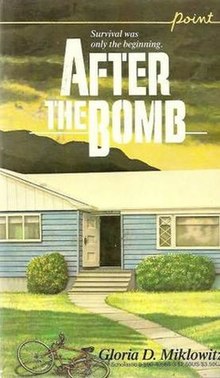 By GLORIA D. MIKLOWITZ (Scholastic; 1985)
By GLORIA D. MIKLOWITZ (Scholastic; 1985)
A very eighties Cold War inflected post-nuke novel. This means a bleak reality-based drama that flaunts its scientific accuracy, with a lengthy prefatory note assuring us that “the events of this book, while fictitious, are based on what might well happen in the event of a single, one-megaton bomb falling on any large city in the world,” and a bibliography. Furthermore, this is a young adult novel, so the message-heavy gist is de rigeur, as is the uninvigorating nuance-free prose.
The setting is the San Fernando Valley, and the situation (as the above quote makes clear) the detonation of a one-megaton nuclear bomb. It’s set off in the air a mile over downtown Los Angeles, destroying everything within a five mile radius and spreading firestorms throughout the land. The horrific result: countless casualties and medical issues, and a mass migration amid the surviving populace.
All this takes until 32 pages in to occur. Before then we’re introduced to the suburban existence of a deeply uninteresting teenager named Philip. His problems include the fact that he’s love with Cara, the attractive GF of Philip’s tres cool brother Matt, and has to listen to constant radio broadcasts about international tensions that he finds “Boring…there were enough things he couldn’t do anything about right here, at home and at school.”
Eventually Phil, fed up with life, retreats into an underground bunker located in his back yard. It’s after he’s joined by Matt and Cara that the bomb is detonated, rendering the world an entirely different place than it was minutes earlier. Survival is now a constant challenge, made all the more difficult by the fact that Philip’s father is away at work, his mother badly burned and the seemingly indomitable Matt proving himself worthless in a crisis situation. Hence, Philip has to become a hero whether he wants to or not.
This is a YA book, so the fact that its author pulls her punches is to be expected. It’s a sanitized PG rated depiction of the apocalypse, albeit with some select nastiness (such as a mini-drama involving a charred baby, something it seems all modern post-nuke narratives require) and a real sense of tightly wound alarm. It’s that which keeps the pages turning, and belies the suspense-free narrative, too-short 156 page length and unsatisfying cliffhanger finale. Could it be that the author and publisher intended a sequel to this book? I wouldn’t put it past them.
